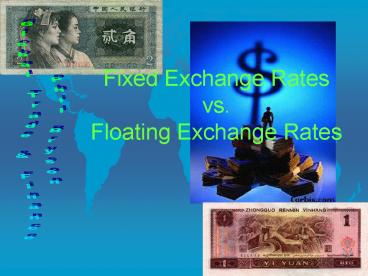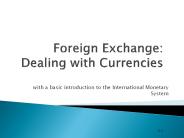Fixed Exchange Rates vs. Floating Exchange Rates - PowerPoint PPT Presentation
1 / 26
Title:
Fixed Exchange Rates vs. Floating Exchange Rates
Description:
Fixed Exchange Rates vs. Floating Exchange Rates Exchange Rate Regimes What are fixed Exchange Rates? - Officials commit to maintaining the exchange rate at a ... – PowerPoint PPT presentation
Number of Views:863
Avg rating:3.0/5.0
Title: Fixed Exchange Rates vs. Floating Exchange Rates
1
Fixed Exchange Ratesvs.Floating Exchange Rates
Global Trade Finance Phil Bryson
2
Exchange Rate Regimes
- What are fixed Exchange Rates?
- - Officials commit to maintaining the exchange
rate at a specific level.
3
Exchange Rate Regimes
- What are Floating Exchange Rates?
- - No intervention from bankers or government
officials. The market determines the price of
the currency.
4
Exchange Rate Regimes
- What is a clean float? A dirty one?
- - With a dirty float the government doesnt peg
the currency, but tries from time to time to
influence the rate by buying or selling in the
currency markets.
5
Fixed Exchange Rates
- How can the government keep a currency at a
certain value if international commerce becomes
unwilling to pay that price? - It cant maintain the value for long. If the
demand for the currency falls, its price would
fall as well.
6
Fixed Exchange Rates
- The only way the price can be kept up is for the
government promising to maintain the original
level to enter the foreign exchange market and
bid the price of the currency back up by
purchasing it.
7
Fixed Exchange Rates
- The government must buy the amount that will
bring the quantity demanded back to the original
level.
Price of Franc
Supply of Francs
Demand for Francs
Quantity of exchange
8
Fixed Exchange Rates
- To what does the government fix the value of its
currency? - When or how often does the country change the
value of its fixed rate?
9
Fixed Exchange Rates
- How does the government defend the fixed value
against any market pressures pushing toward
higher or lower exchange rate value?
10
Fix to what?
- In the past, all currencies were fixed to gold.
- Today, a country can fix its value to another
countrys currency.
11
Fix to what?
- A country can fix its currency to a basket of
other currencies. - -Same as diversifying a portfolio (Not putting
all your eggs in one basket) - -Special Drawing Right (SDR)A basket of four
major world currencies.
12
Defending a Fixed Exchange Rate
- To buy or sell foreign currencies (in order to
influence the prevailing exchange rate), a
government must have foreign exchange reserves. - It is not likely to have enough reserves to
defend against a massive and sustained attack on
the currency. What is an attack on a countrys
currency? - (Answer Massive selling off of a currency
expected to be devalued. One can borrow the
attacked currency and pay it back after
devaluation.)
13
Defending a Fixed Exchange Rate in the Exchange
Markets the Interest Rates
- How can higher i rates keep the currency value
up? - (Answer Foreigners will purchase the nations
currency, bidding its value upward, to make
short-term investments in the country.)
14
Defending a Fixed Exchange Rate by changing the
fundamentals
- Long-term adjustments of its macroeconomic
(monetary and/or fiscal) policy. - Budget austerity avoids inflation and takes
downward pressure off currency.
15
Inflation Puts Downward Pressure On the Exchange
Rate
- THE DEMAND SIDE
- Non-inflating countries are unwilling to pay more
and more to buy an inflating countrys goods and
services. Reduced demand for the inflating
currency will make it depreciate.
16
Inflation Puts Downward Pressure On the Exchange
Rate
- SUPPLY SIDE
- Citizens of the inflating country will want to
seek bargains through imports, selling their
currency to obtain other currencies. Selling
increases the supply and drives the price down
further.
17
EXAMPLE Defending The Peso Under Attack
- Assume the Peso has been inflating in Mexico
- Downward pressure will be on the peso. (Less
demand for it, since fewer will be purchased with
Mexican prices going up.)
18
Defending The Peso Under Attack
- The Mexican government intervenes in currency
markets, purchasing pesos to maintain their value
and promises it will never permit its value to
fall.
19
Defending The Peso Under Attack
- The attack will be under way if people dont
believe the promise. People sell their pesos for
dollars, etc., while the price is still up. Note
borrow money in Mexico, change it quickly for
dollars. Pay back the loan later with cheap pesos.
20
Defending The Peso Under Attack
- The Mexican government soon runs out of reserves
and lets the peso price fall. - People purchase pesos back at the new, lower rate
for good gains.
21
When to Change the Rate?
- Why might a government want to change the
exchange value of its currency? - It might do so in order to promote, for example,
greater export volume.
22
When to Change the Rate?
- A pegged exchange rate sets a targeted value for
a countrys foreign exchange, and the government
can adjust the peg. - The government may use an adjustable peg.
- or a crawling peg. The rate may be changed if
there is a substantial disequilibrium in the
countrys international position (e.g., demand
for the currency is too weak to maintain the
desired value).
23
Monetary Policy with Fixed Exchange Rates
Expanding the Money Supply Worsens the Balance of
Payments
Capital flows out.
(in the short run)
To improve a poor macroeconomic situation, a
country increases its money supply so that banks
are more willing to lend.
The overall payments balance worsens.
Interest rate drops
The Current account balance worsens as exports
fall and imports increase.
Real spending, production, and income rise, but
The price level increases.
24
Monetary Policy with Floating Exchange Rates
Effects of Expanding the Money
Supply
Capital flows out.
(In the short run)
Currency depreciation and automatic adjustment
begins!
The Current account balance improves
Real product and income rise more
Interest rate drops
With an increase in the money supply, banks are
more willing to lend.
Real spending, production, and income rise.
Current account balance worsens.
The Price level increases.
(Beyond the short run)
25
In Conclusion
- Fixed exchange rates are government controlled.
- Floating exchange rates are market driven.
26
In Conclusion
- But as financial markets have developed to
accommodate for flexible exchange rates, more and
more countries have come to appreciate the value
of market determination.































